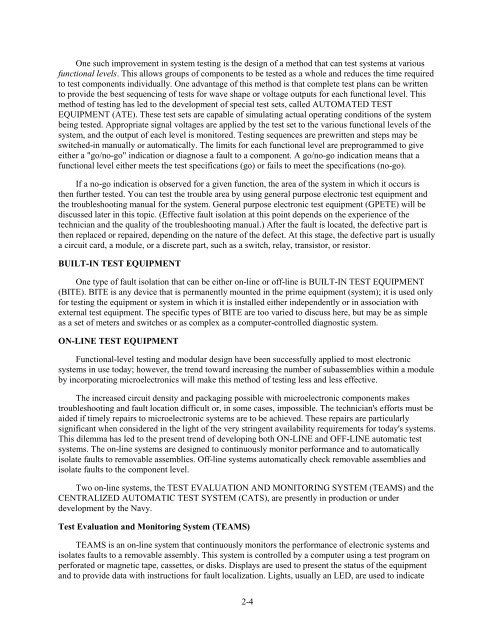Navy Electricity and Electronics Training Series - Historic Naval ...
Navy Electricity and Electronics Training Series - Historic Naval ...
Navy Electricity and Electronics Training Series - Historic Naval ...
Create successful ePaper yourself
Turn your PDF publications into a flip-book with our unique Google optimized e-Paper software.
One such improvement in system testing is the design of a method that can test systems at variousfunctional levels. This allows groups of components to be tested as a whole <strong>and</strong> reduces the time requiredto test components individually. One advantage of this method is that complete test plans can be writtento provide the best sequencing of tests for wave shape or voltage outputs for each functional level. Thismethod of testing has led to the development of special test sets, called AUTOMATED TESTEQUIPMENT (ATE). These test sets are capable of simulating actual operating conditions of the systembeing tested. Appropriate signal voltages are applied by the test set to the various functional levels of thesystem, <strong>and</strong> the output of each level is monitored. Testing sequences are prewritten <strong>and</strong> steps may beswitched-in manually or automatically. The limits for each functional level are preprogrammed to giveeither a "go/no-go" indication or diagnose a fault to a component. A go/no-go indication means that afunctional level either meets the test specifications (go) or fails to meet the specifications (no-go).If a no-go indication is observed for a given function, the area of the system in which it occurs isthen further tested. You can test the trouble area by using general purpose electronic test equipment <strong>and</strong>the troubleshooting manual for the system. General purpose electronic test equipment (GPETE) will bediscussed later in this topic. (Effective fault isolation at this point depends on the experience of thetechnician <strong>and</strong> the quality of the troubleshooting manual.) After the fault is located, the defective part isthen replaced or repaired, depending on the nature of the defect. At this stage, the defective part is usuallya circuit card, a module, or a discrete part, such as a switch, relay, transistor, or resistor.BUILT-IN TEST EQUIPMENTOne type of fault isolation that can be either on-line or off-line is BUILT-IN TEST EQUIPMENT(BITE). BITE is any device that is permanently mounted in the prime equipment (system); it is used onlyfor testing the equipment or system in which it is installed either independently or in association withexternal test equipment. The specific types of BITE are too varied to discuss here, but may be as simpleas a set of meters <strong>and</strong> switches or as complex as a computer-controlled diagnostic system.ON-LINE TEST EQUIPMENTFunctional-level testing <strong>and</strong> modular design have been successfully applied to most electronicsystems in use today; however, the trend toward increasing the number of subassemblies within a moduleby incorporating microelectronics will make this method of testing less <strong>and</strong> less effective.The increased circuit density <strong>and</strong> packaging possible with microelectronic components makestroubleshooting <strong>and</strong> fault location difficult or, in some cases, impossible. The technician's efforts must beaided if timely repairs to microelectronic systems are to be achieved. These repairs are particularlysignificant when considered in the light of the very stringent availability requirements for today's systems.This dilemma has led to the present trend of developing both ON-LINE <strong>and</strong> OFF-LINE automatic testsystems. The on-line systems are designed to continuously monitor performance <strong>and</strong> to automaticallyisolate faults to removable assemblies. Off-line systems automatically check removable assemblies <strong>and</strong>isolate faults to the component level.Two on-line systems, the TEST EVALUATION AND MONITORING SYSTEM (TEAMS) <strong>and</strong> theCENTRALIZED AUTOMATIC TEST SYSTEM (CATS), are presently in production or underdevelopment by the <strong>Navy</strong>.Test Evaluation <strong>and</strong> Monitoring System (TEAMS)TEAMS is an on-line system that continuously monitors the performance of electronic systems <strong>and</strong>isolates faults to a removable assembly. This system is controlled by a computer using a test program onperforated or magnetic tape, cassettes, or disks. Displays are used to present the status of the equipment<strong>and</strong> to provide data with instructions for fault localization. Lights, usually an LED, are used to indicate2-4

















